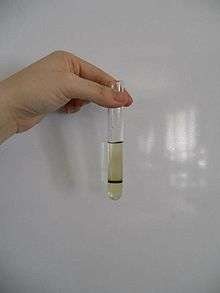Nitrate test
A nitrate test is a chemical test used to determine the presence of nitrate ion in solution. Testing for the presence of nitrate via wet chemistry is generally difficult compared with testing for other anions, as almost all nitrates are soluble in water. In contrast, many common ions give insoluble salts, e.g. halides precipitate with silver, and sulfate precipitate with barium.
The nitrate anion is an oxidizer, and many tests for the nitrate anion are based on this property. Unfortunately, other oxidants present in the analyte may interfere and give erroneous results.
Nitrate can also be detected by first reducing it to the more reactive nitrite ion and using one of many nitrite tests.[1]
Ring test

A common nitrate test, known as the brown ring test[2] can be performed by adding iron(II) sulfate to a solution of a nitrate, then slowly adding concentrated sulfuric acid such that the acid forms a layer below the aqueous solution. A brown ring will form at the junction of the two layers, indicating the presence of the nitrate ion.[3] Note that the presence of nitrite ions will interfere with this test.[4]
The overall reaction is the reduction of the nitrate ion to nitric oxide by iron(II), which is oxidised to iron(III), followed by the formation of a nitrosyl complex between the nitric oxide and the remaining iron(II), where nitric oxide is reduced to NO−.[5]
- 2HNO3 + 3H2SO4 + 6FeSO4 → 3Fe2(SO4)3 + 2NO + 4H2O
- [Fe(H2O)6]SO4 + NO → [Fe(H2O)5(NO)]SO4 + H2O
This test is sensitive up to 2.5 micrograms and a concentration of 1 in 25,000 parts.[6]
Devarda's test
Devarda's alloy (Copper/Aluminium/Zinc) is a reducing agent. When reacted with nitrate in sodium hydroxide solution, ammonia is liberated. The ammonia formed may be detected by its characteristic odor, and by damp red litmus paper's turning blue, signalling that it is an alkali — very few gases other than ammonia evolved from wet chemistry are alkaline.
- 3 NO−
3 + 8 Al + 5 OH−
+ 18 H
2O → 3 NH
3 + 8 [Al(OH)
4]−
Aluminium is the reducing agent in this reaction that will occur.
Diphenylamine test
Diphenylamine may be used as a wet chemical test for the presence of the nitrate ion. In this test, a solution of diphenylamine and ammonium chloride in sulfuric acid is used. In the presence of nitrates, diphenylamine is oxidized, giving a blue coloration. This reaction has been used to test for organic nitrates as well.,[7] and has found use in gunshot residue kits detecting nitroglycerine and nitrocellulose.[8]
Copper turnings test
The nitrate ion can easily be identified by heating copper turnings along with concentrated sulfuric acid. Brown, pungent effervescence is observed which turns blue litmus red.
Here sulphuric acid reacts with the nitrate ion to form nitric acid. Nitric acid then reacts with the copper turnings to form nitric oxide. Nitric oxide is thus oxidised to nitrogen dioxide.
- Cu + 4 HNO
3 → Cu(NO
3)
2 + 2 NO
2 +2H
2O
See also
References
- Moorcroft, Matthew J.; Davis, James; Compton, Richard G. "Detection and Determination of Nitrate and Nitrite: A Review". Talanta. 54 (5): 785–803. doi:10.1016/S0039-9140(01)00323-X.
- Egon Wiberg, Arnold Frederick Holleman (2001) Inorganic Chemistry, Elsevier ISBN 0-12-352651-5
- Mascetta, Joseph A. Barron's How to Prepare for the SAT II: Chemistry, 7th edition. Barron's Educational Series, Inc., 2002. p208.
- Holltzclaw, H; Robinson, W. College Chemistry with qualitative analysis, 8th edition, D. C. Heath and Company:Lexington, MA, 1988, p. 1007.
- Alicja Wanat, Thorsten Schneppensieper, Grażyna Stochel, Rudi van Eldik, Eckhard Bill, and Karl Wieghardt (2002). "Kinetics, Mechanism, and Spectroscopy of the Reversible Binding of Nitric Oxide to Aquated Iron(II). An Undergraduate Text Book Reaction Revisited". Inorganic Chemistry. 41 (1): 4–10. doi:10.1021/ic010628q. PMID 11782137.CS1 maint: multiple names: authors list (link) Formerly it was thought that the complex contains Fe(I) and NO+.
- https://chemistry.stackexchange.com/questions/67354/how-to-test-for-lead-and-nitrates-in-water; Nilay Ghosh
- http://nvlpubs.nist.gov/nistpubs/jres/049/jresv49n3p163_A1b.pdf
- Pamela K. Walker and Philip J. Rodacy (2002). "Field Test Kit for Gunshot Residue Detection" (PDF). Sandia National Laboratories. Cite journal requires
|journal=(help)